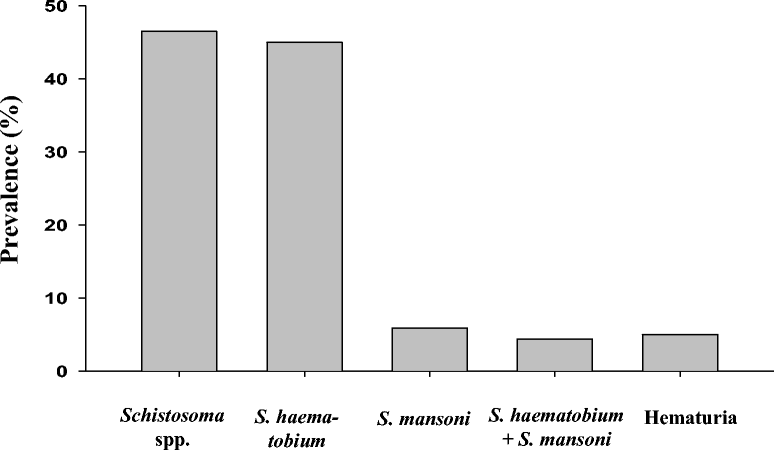Prevalence, risk factors, and clinical manifestations of schistosomiasis among school children in the White Nile River basin, Sudan
- PMID: 25312470
- PMCID: PMC4200116
- DOI: 10.1186/s13071-014-0478-6
Prevalence, risk factors, and clinical manifestations of schistosomiasis among school children in the White Nile River basin, Sudan
Abstract
Background: We investigated the prevalence, risk factors, and clinical manifestations of schistosomiasis in White Nile State, Sudan, to determine the local characteristics of schistosomiasis in the White Nile River basin.
Methods: Urine and stool samples were collected from 338 students (176 boys, 162 girls) at three primary schools and were examined using the urine filtration method and the Kato-Katz technique, respectively. Of the students, 200 were interviewed using a semi-structured questionnaire to assess water-contact patterns and health conditions related with urinary schistosomiasis.
Results: Of the 338 students, egg-positive rates for S. haematobium and S. mansoni were 45.0% and 5.9%, respectively, and 4.4% were mixed. The intensities of S. haematobium and S. mansoni infection were 1.091 ± 0.744 log EP10 (eggs per 10 mL of urine, mean ± SD = 57 ± 172 EP10) and 1.787 ± 0.844 log EPG (eggs per gram of stool, mean ± SD = 156 ± 176 EPG), respectively. The prevalence and intensity of S. haematobium infection differed significantly among the three schools, but not by gender or age. Urinary schistosomiasis was significantly associated with the frequencies of contaminated water contact, taking baths, swimming, and wading the stream; however, frequencies of these events were not significantly correlated with infection intensity. Self-reported hematuria and dysuria also correlated significantly with urinary schistosomiasis.
Conclusions: The overall prevalence of schistosomiasis, especially urinary schistosomiasis, is high in the White Nile River basin, Sudan, and is closely associated with frequencies of water contact, taking baths, swimming, and wading the stream. We strongly recommend implementation of an integrated schistosomiasis control program in this area.
Figures


References
-
- Bruun B, Aagaard-Hansen J: The Social Context Of Schistosomiasis And Its Control. In Geneva: World Health Organization; 2008:2.
-
- WHO Schistosomiasis : number of people treated in 2011. Wkly Epidemiol Rec. 2013;88:81–88. - PubMed
MeSH terms
LinkOut - more resources
Full Text Sources
Other Literature Sources

